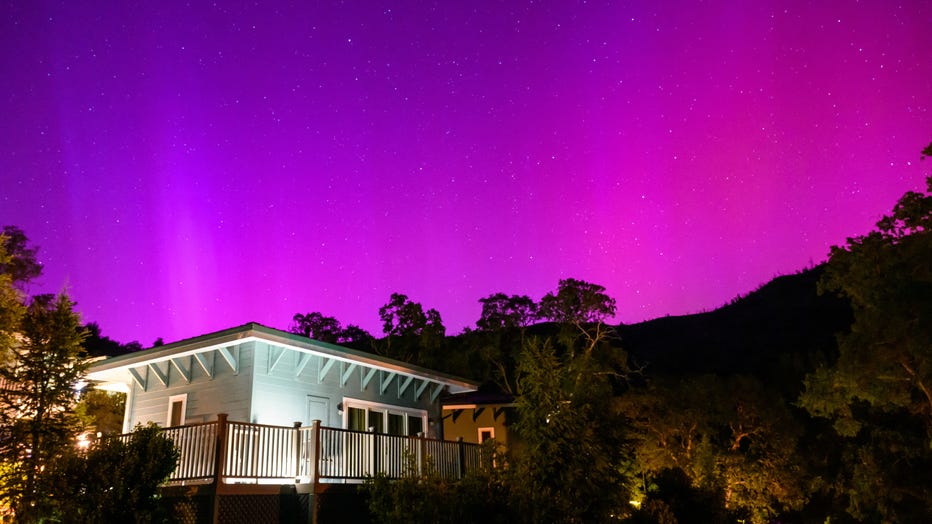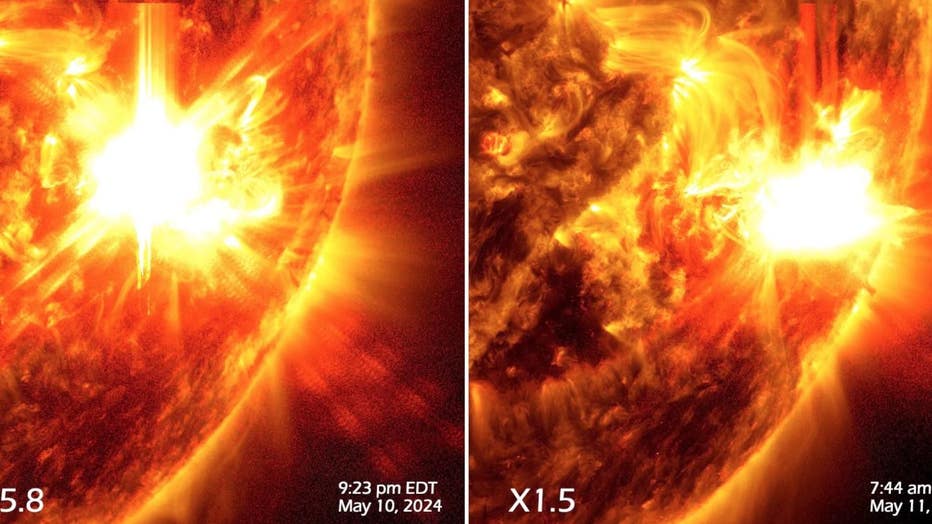Northern Lights visible as far south as Florida, geomagnetic storm to continue

Rare G5 geomagnetic storm triggers Northern Lights in US
An 'extreme' G5-level solar storm is happening for the first time since 2003, triggering Northern Lights in some Southern states as far as Alabama and Georgia. The Space Weather Prediction Center issued its first "severe" Geomagnetic Storm Watch since January 2005 and said the event was the most powerful since the Halloween event of 2003. LiveNOW's Austin Westfall spoke about the celestial phenomenon with SWPC Coordinator Shawn Dahl.
Northern lights were visible in much of the U.S. and across the world on Friday.
The Space Weather Prediction Center (SWPC) said satellites observed conditions that reached level 5 on their 5-point scale of geomagnetic activity Friday evening, noted as an "extreme" event and the first such storm to reach that level since October 2003.
Geomagnetic storms can impact infrastructure in near-Earth orbit and on Earth’s surface, potentially disrupting communications, the electric power grid, navigation, radio and satellite operations.
The extreme 2003 geomagnetic storm, for example, took out power in Sweden and damaged power transformers in South Africa.
There were no immediate reports of disruptions to power and communications from Friday’s storm.
RELATED: Solar flare could disrupt communications, produce northern lights
Meanwhile, conditions have since drifted back to a level 4 storm Saturday morning, and more geomagnetic activity is heading Earth's way over the weekend from additional solar flares, possibly lasting into early next week.
Will we see Northern Lights again tonight?

Northern lights or aurora borealis illuminate the night sky over a campers tent north of San Francisco in Middletown, California on May 11, 2024. (Photo by Josh Edelson/AFP via Getty Images)
Northern Light displays, typically relegated to states along the Canadian border during a typical geomagnetic storm, reached as far as the Gulf Coast Friday, with pink, green and purple skies reported in Florida, Texas and Alabama.
The combination of clear skies and a waxing crescent Moon likely led to the display being visible from most of the continental U.S. for the first time since World War II.
For those under cloudy skies or near light pollution, chances to see an aurora were expected to continue through the weekend.
The SWPC said it is "very likely" the geomagnetic storming will persist through the weekend as several additional coronal mass ejections (CMEs) are in transit to Earth’s outer atmosphere.
"The threat of additional strong flares and (Coronal Mass Ejections) will remain until the large and magnetically complex sunspot cluster (NOAA region 3664) rotates out of view over the next several days," the SWPC wrote in a Saturday morning update.
It is hard to predict the storm’s effect, but you can check SWPC’s aurora dashboard here.
Check your local FOX forecast as well.
RELATED: See Northern lights photos as strong solar storm hits Earth
2024 solar storm
The U.S. National Oceanic and Atmospheric Administration issued a rare severe geomagnetic storm warning when a solar outburst reached Earth on Friday afternoon, hours sooner than anticipated.
The sun has produced strong solar flares since Wednesday, resulting in at least seven outbursts of plasma. Each eruption, known as a coronal mass ejection, can contain billions of tons of plasma and magnetic field from the sun’s outer atmosphere, or corona.
The flares seem to be associated with a sunspot that’s 16 times the diameter of Earth, NOAA said. It is all part of the solar activity ramping up as the sun approaches the peak of its 11-year cycle.
NASA shared photos of two solar flares, one from Friday night and one early Saturday.

NASA’s Solar Dynamics Observatory captured images of the two solar flares on May 10 and May 11, 2024. The image shows a subset of extreme ultraviolet light that highlights the extremely hot material in flares created from a mixture of SDO’s AIA 193,
The flares are classified as X5.8 and X1.5-class flares, respectively. X-class denotes the most intense flares, while the number provides more information about its strength, NASA said.
The most intense solar storm in recorded history, in 1859, prompted auroras in central America and possibly even Hawaii.
This story was reported from Detroit. FOX Weather and The Associated Press contributed.

